Southampton have recently been relegated from the Premier League and are looking to bounce back instantly following the appointment of young manager Russell Martin.
Through set-piece tinted glasses, we take a special interest in the work of Andreas Georgson, who has only just been appointed as Southampton’s set-piece coach at the start of August, around three weeks prior to this piece coming out.
Andreas Georgson arrives at Staplewood following successful experiences as a set-piece coach at Arsenal, Brentford and Malmö FF.
Having joined Southampton after the season had already started, there has been limited time to share his knowledge with the side and a limited amount of opportunity to execute those routines on matchday, yet some interesting ideas have arisen instantly.
In the three league games following his arrival, Southampton have already scored three goals thanks to set-plays, whether directly from a corner kick delivery or from winning a penalty following a dead ball situation.
In this Andreas Georgson tactical analysis, we will look into the tactics behind Southampton’s offensive set plays, with an in-depth analysis of how their main corner routine has been used.
This set-piece analysis will examine why this routine has instantly led to success, where it can be improved, and evaluate their other set play routines and the principles used throughout.
Andreas Georgson Corner Setup
So far, although we are only in the season’s opening weeks, Southampton have stuck to one main corner routine in regards to the starting positions of each player.
The image below shows that they use five players inside the box, three hanging around the back of the six-yard box, while two players are in the middle of the six-yard line.
One attacker is always next to the corner taker, leaving opposing teams with the potential threat of defending against a short corner.
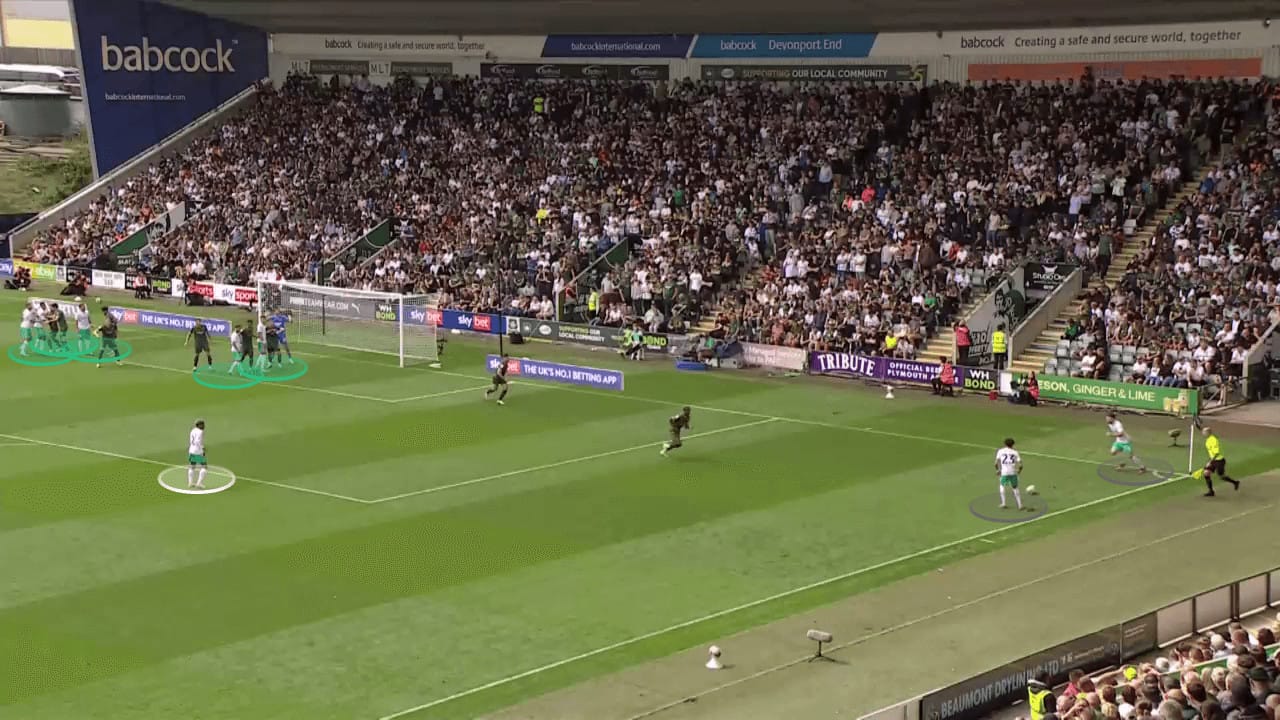
Alongside the five attackers and two players starting by the ball, Southampton place three players around the edge of the penalty box.
Like in their open play, a central principle of Saints’ set plays is to sustain pressure.
By having three players on the edge of the box, Southampton can quickly win back possession of the ball should it be cleared and have multiple options surrounding the box, looking to receive the ball following short corner routines.
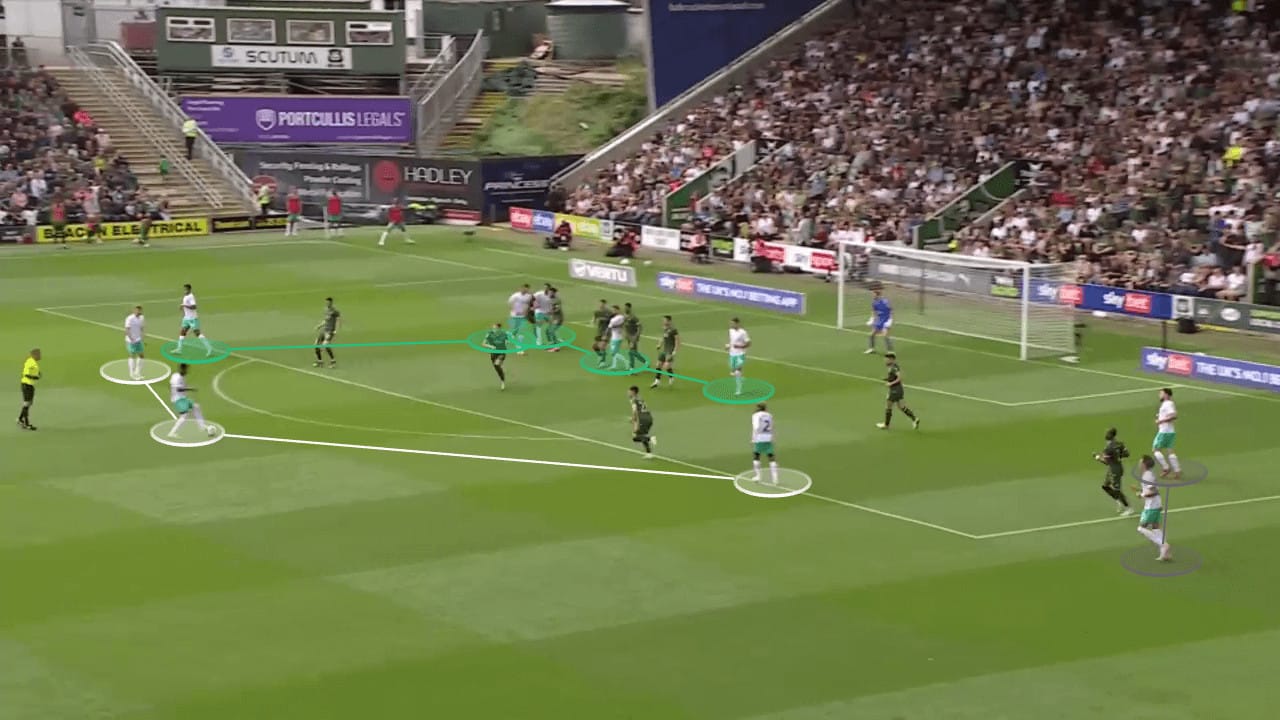
Andreas Georgson Use of Decoy Runs & Screens
One of the main methods in which Southampton have attempted to create openings inside the six-yard box has been through the use of decoy runs.
The two players, located by the middle of the six-yard line, are tasked with attaching themselves to the zonal markers before making decoy runs towards the ball. This provides two main benefits;
1) dragging defenders away from the middle of the six-yard line (target area)
2) opportunities for flick-ons to the back post in case of under-hit crosses or heavy zonal presences in the target area
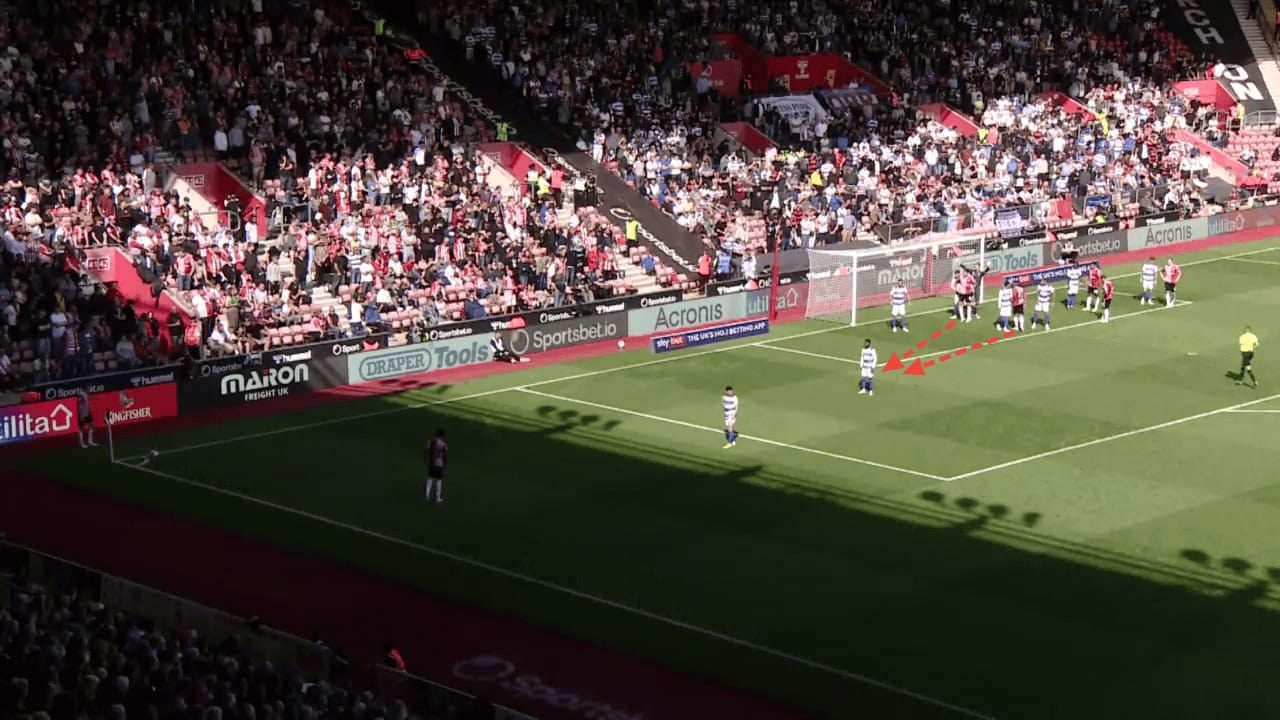
Positioning an attacker close to a zonal marker captures their attention, giving them a sense of responsibility for that player.
In that way, you can bait a zonal defender into man-marking an attacker before dragging them away from their zone of responsibility through a decoy run.
As shown in the example below, the zonal defender follows the attacker out of the target area before the deeper attackers attack the area, using the run-up to generate momentum and gain the aerial advantage over the vulnerable defensive zonal presence.
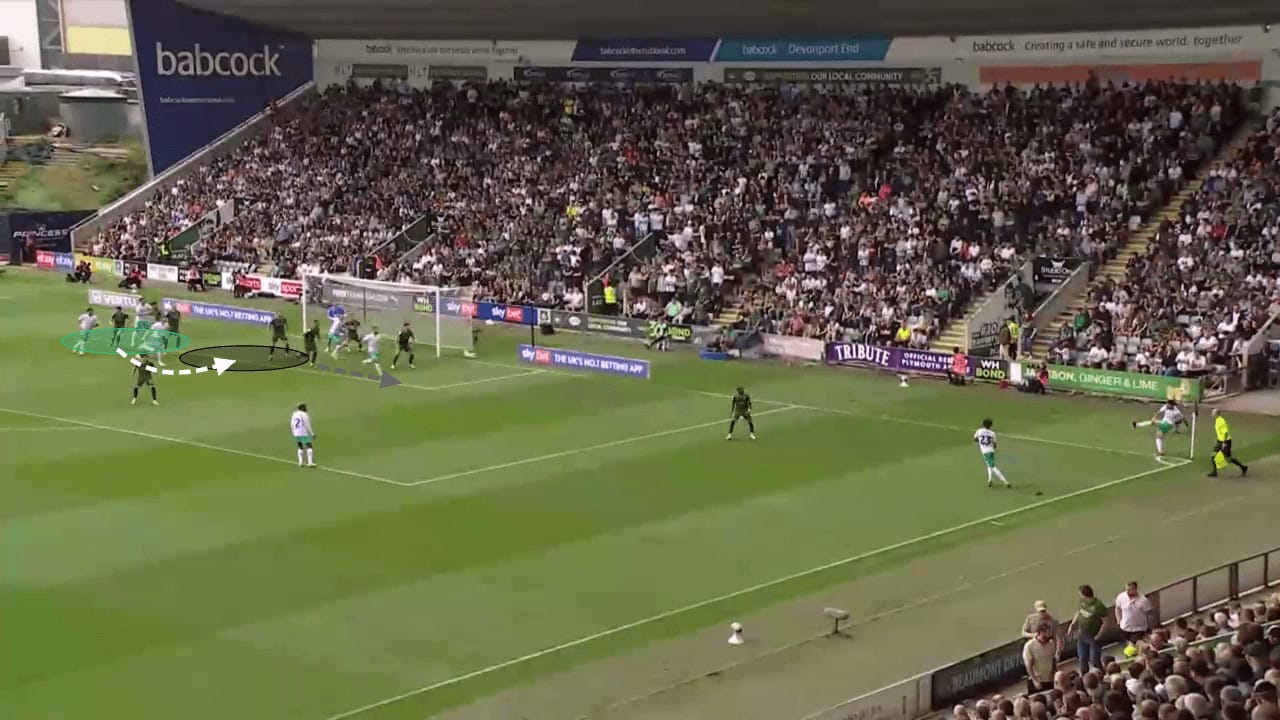
A slight variation of this routine has been utilised in the season’s early stages, where the attacking unit has had an overload at the back side of the six-yard box.
With the heavy overload (4v2) against a pure zonal marking system, Southampton have created space efficiently with the help of decoy runs.
We can see in the example below that two attackers move towards the near side of the six-yard box, encouraging the zonal markers to follow them.
This then leaves massive spaces at the back side of the six-yard box, where the remaining attackers can wait for the ball to land at their feet.
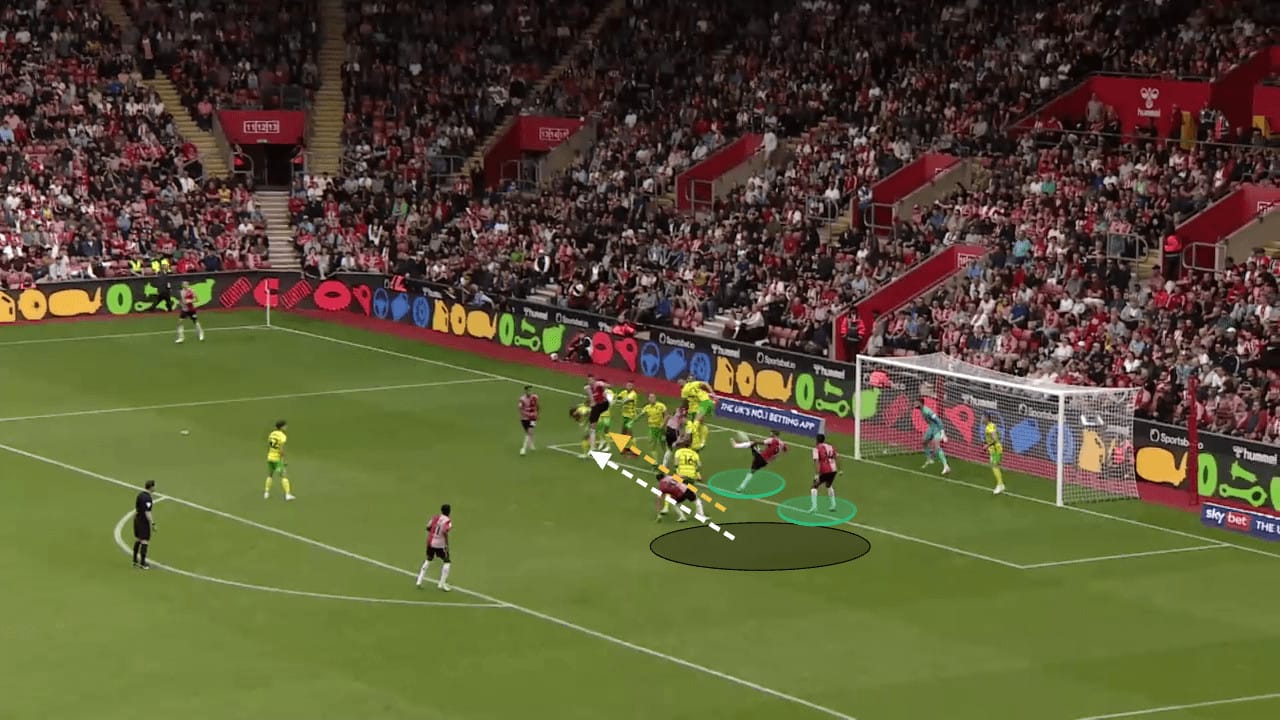
Another more recent method in which Southampton have made the most of their overloads at the back post has been through the use of screens.
Opposing teams haven’t been able to react well to Saints’ setups and so have usually struggled to deal with the overloads at the back post whilst simultaneously trying to prevent decoy runners from making the first contact at the near post.
This could be combated by increasing the number of defenders inside the six-yard box to at least numerically match up with Southampton’s attackers.
At the back post, with a clear 3v2 advantage, the spare man has been used to perform a screen to provide one of the attackers the complete freedom to attack the ball without any defensive disruption.
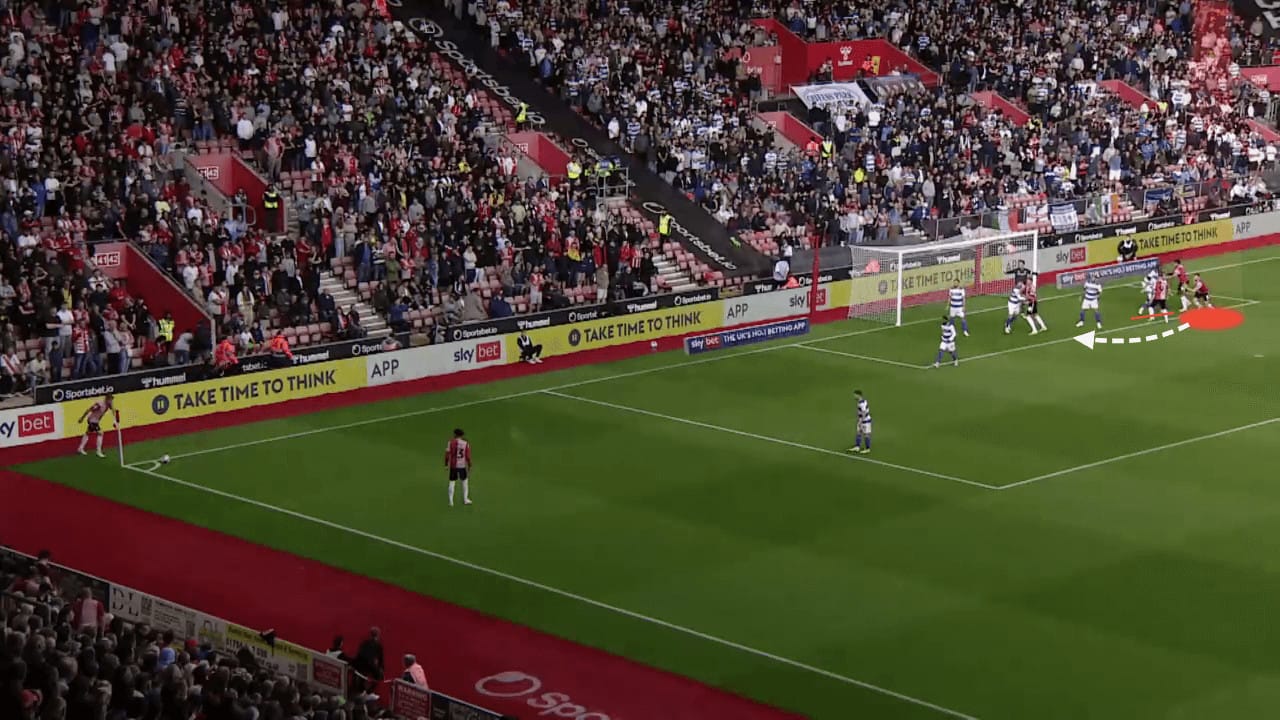
Saints have used other methods to create space for their attackers when facing teams without any numerical advantages.
The attacking group at the back post, attempts to position themselves tightly together.
With each attacker being touch-tight to one another, players are able to gain separation from their defender more simply.
The example below shows two attackers in close proximity, where the farther attacker runs towards the target area, narrowly missing his teammate.
In doing so, it becomes impossible for the defender to remain tight to the player, as there is no room for the pair to run side by side.
The defender has to avoid the block and take the long way around to find their marker.
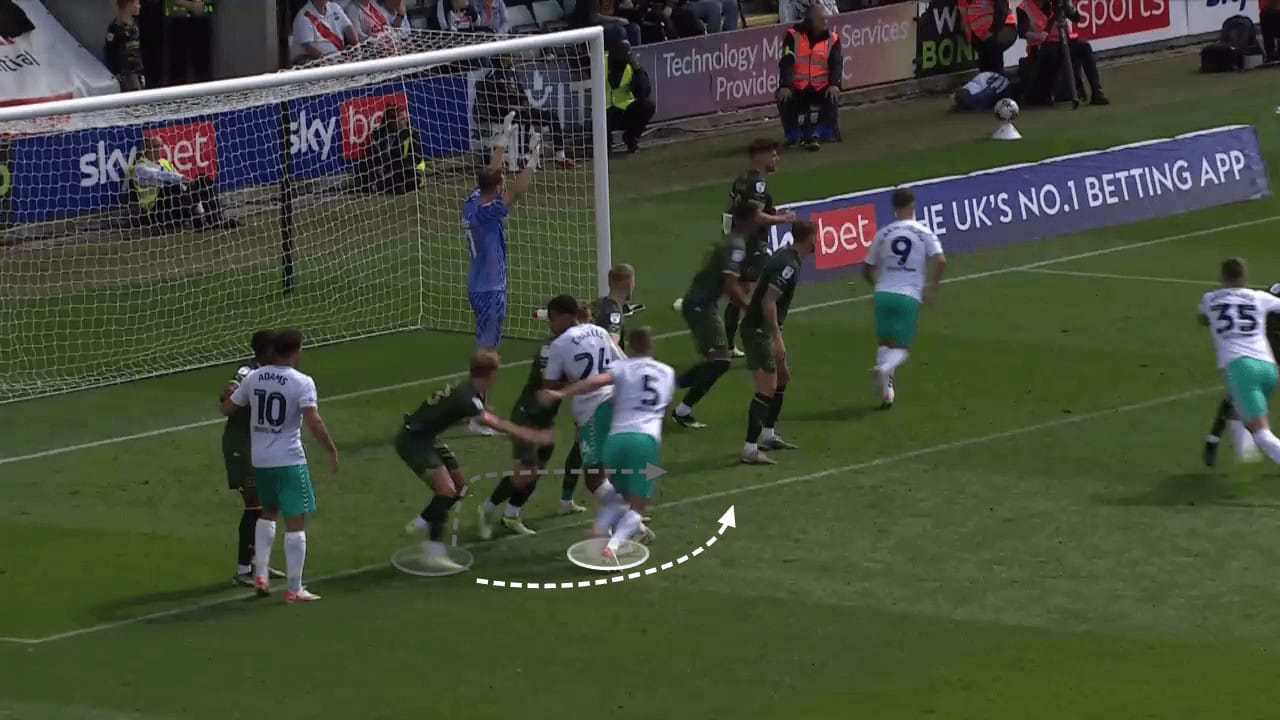
One issue that Southampton have faced with their intentions to cross the ball to the mid/back side of the six-yard box is that it gives the goalkeeper added time to step off their line and claim the ball.
As seen in the example below, even though the attacker is heads and shoulders above the defender, thanks to the prior use of a screen, the goalkeeper has sufficient time to claim the ball, using their arm span to be the first to reach the ball.
Southampton could combat this by placing a player to mark the goalkeeper to prevent them from being able to step out and claim the ball.
However, it comes at the risk of either losing a player outside the box, thus giving up potential control, or reducing the number of players ready to attack the ball, reducing the likelihood of an attacking player making the first contact.
However, by giving the goalkeeper complete freedom, the rest of the attacking positions become irrelevant, as the goalkeeper consistently can claim the ball, killing attacks before they even begin.

A final benefit of throwing players into the six-yard box is that it forces the defending side to be constrained inside their own six-yard box.
As a result of the majority of a team being confined to just their own six-yard box, the defending team is vulnerable during second balls from rebounds or flick-ons.
We can see in the image below that four attackers can corner the opposition into a small area, where then any ball that bounces into the area outside of the six-yard box is likely to be reached by a Saints player first, where they will likely have plenty of time to set themselves up for a shot or pass.
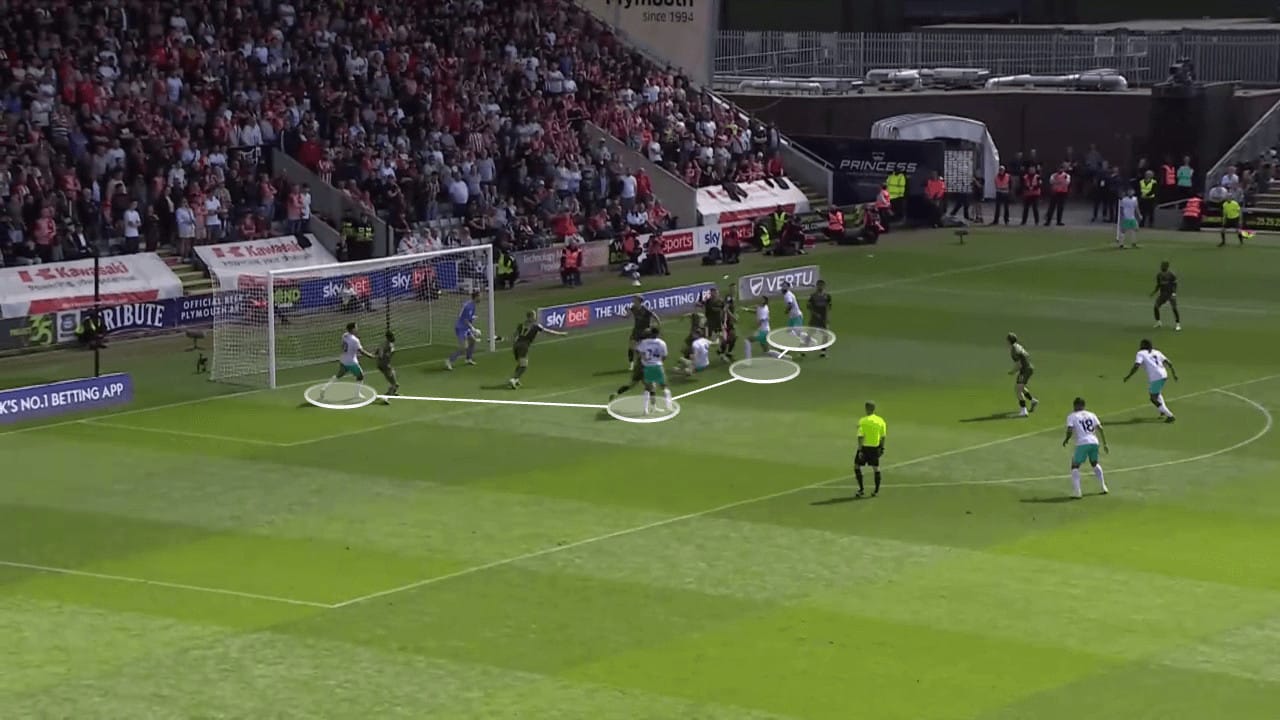
Andreas Georgson Short Variations
Quite a large chunk of Southampton’s corners have been taken short.
This is often the case for one of two reasons: either to take a corner quickly, before the defenders can return to position or to move the ball, so defenders lose concentration and help attackers lose their markers.
One of the benefits of a short corner is that it can create space between the defensive unit and the goal.
A backward pass, as indicated in the image below, is often a trigger for the defensive side to step up to catch attackers offside.
With nine players stepping up during corners, which often involve attackers, there is lots of room for error, with attackers at risk of mistiming when to step up or lacking concentration and forgetting to do so entirely.
This can create gaps in the defensive line, as seen in the example below, where attackers can be goalside of their marker whilst still being onside due to a more profound defender keeping the offside line back.
Although there are gaps in the defensive line, Southampton’s attackers have struggled to get back onside before attacking the space, which shows the room for improvement that has to come.
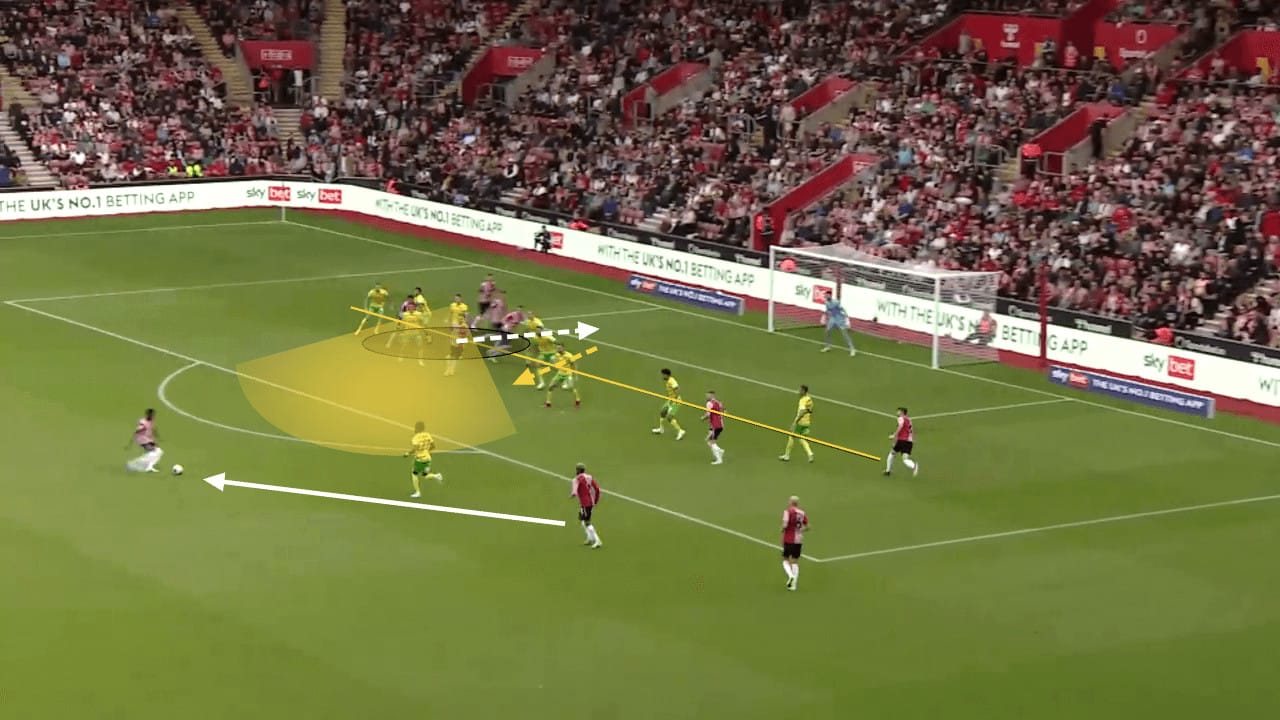
Another fundamental principle that Southampton followed under Georgson’s leadership is to attack the defender’s blindside.
The direct corners have so far exclusively involved players starting at the back post. Southampton have attempted to stick to this principle from short corners, with the short passes providing attackers with the extra inches of space to gain separation from their markers.
One way in which this has also been achieved is through switching play following corners.
In the example below, the corner is taken from the right-hand side before the ball is switched towards the left-hand side of the box.
As this happens, we can see the defenders’ eyes glued to the ball, allowing the attacking unit to reposition themselves back into the defenders’ blindside.
The attackers initially start at the black area, but as the ball’s position moves, they move into the green area to remain in the defender’s blindside, where they can arrive attack the cross unopposed.
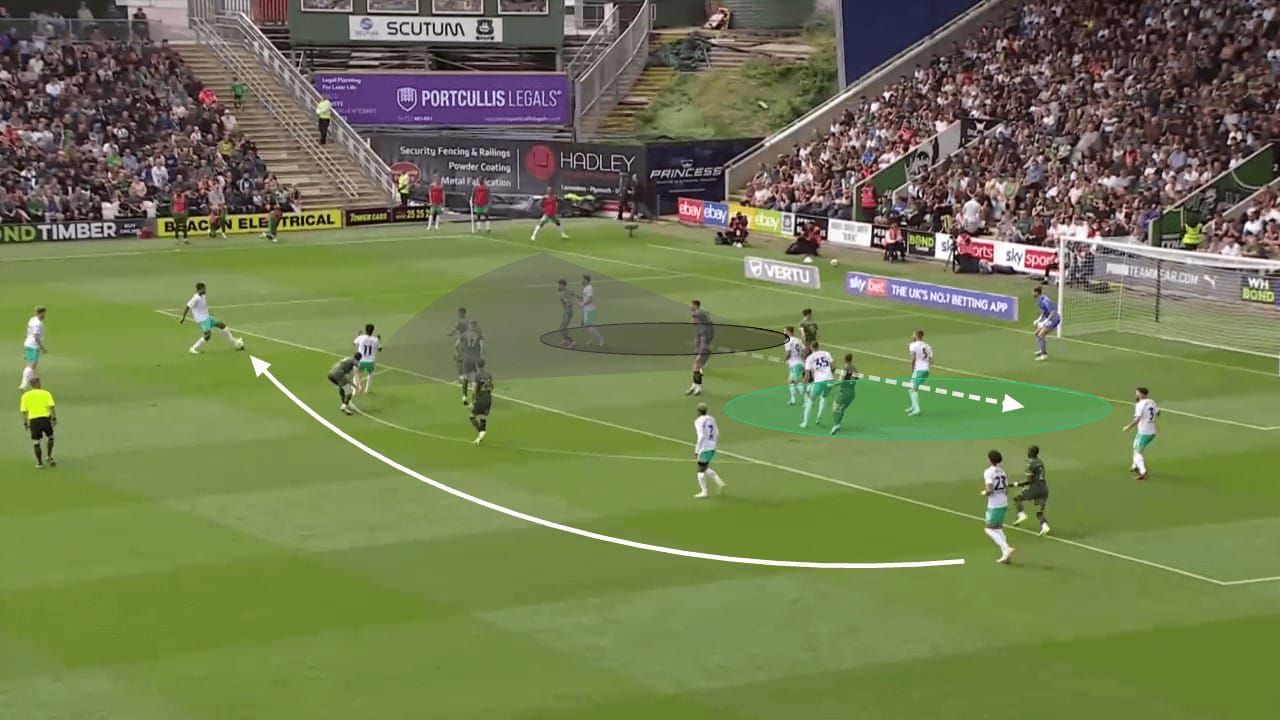
Andreas Georgson Wide Free Kicks
After only a couple of games, Southampton have had a limited amount of attacking free kicks, although positive signs are instantly emerging.
In very wide scenarios, like in the example below, Southampton have stuck to their corner routines, as the angle of the ball’s position is almost identical to a corner.
The two near players set up screens to provide easy access to the middle of the six-yard line, where a deep attacker can time the arrival and attack the ball.
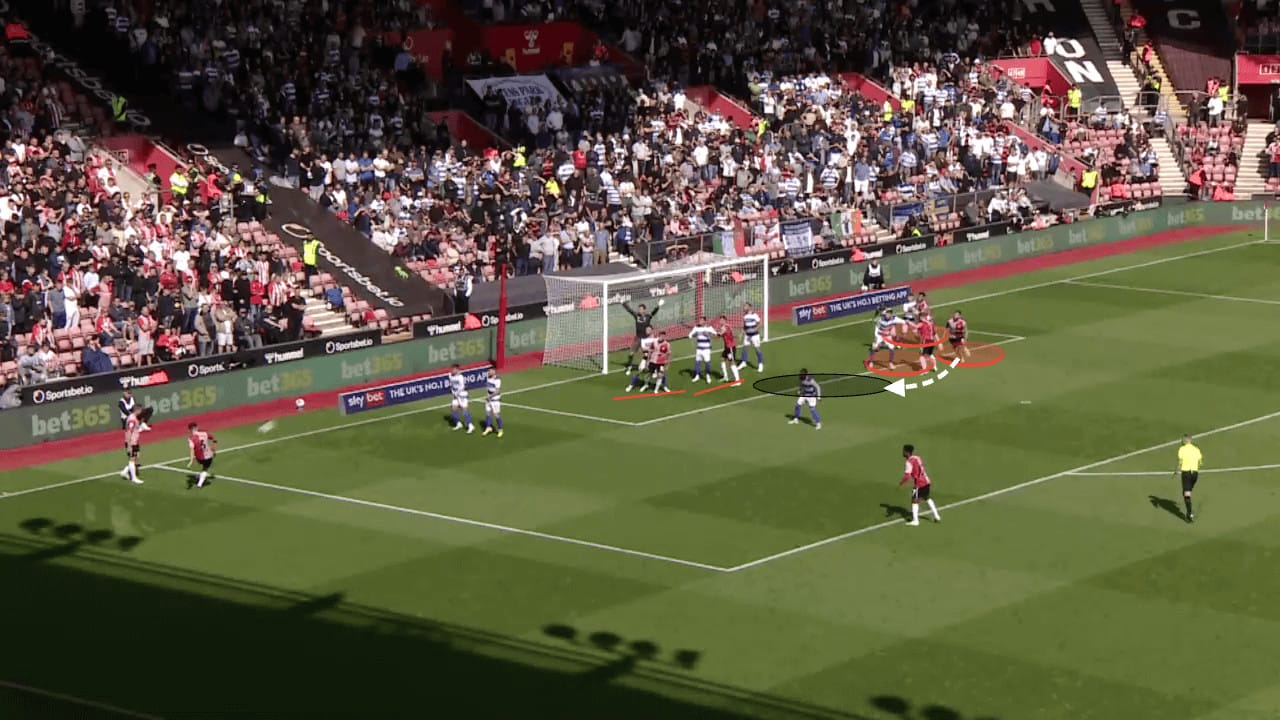
From slightly deeper positions, Southampton have used early runs to disrupt the positioning of the defensive line.
We can see in the example below two players standing over the ball.
The taker highlighted pretends to take the kick, whilst the attacker highlighted inside the box also makes an early decoy run into the box.
This baits a defender into tracking the run, which pushes the offside line back by a few yards whilst the remaining defenders all hold their position.
Creating gaps like these allows Southampton to cause confusion amongst the defensive unit and provide additional spaces inside the box which can be attacked by the Saints players.
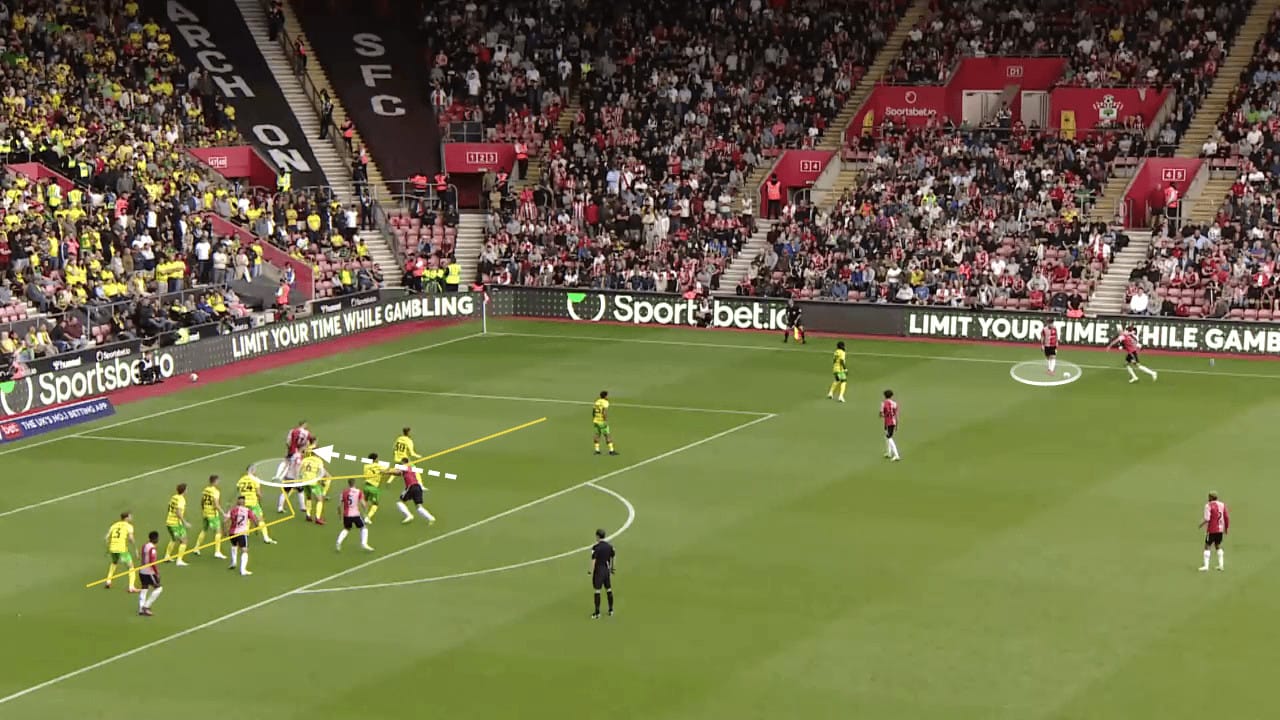
Summary
This Andreas Georgson set piece analysis has explained the many different ways in which Andreas Georgson has only started to develop Southampton’s set-play toolbox.
After only just over three weeks on the job, there is a limit on how much the players can take in and apply to the set pieces whilst simultaneously adapting to a new manager’s style of play.
However, the fact that after such a short period, Southampton have already managed to score a couple of set play goals, as well as winning a penalty off the back of a set play, shows the immediate effect Georgson can have on his team and the sky-high potential of their future set plays.
In the opening weeks, Georgson has understandably focused on one method from corners, which the team is attempting to perfect before hopefully learning a new routine.
With one prepared routine, Southampton are instantly equipped with a dangerous chance-creating method from corners but will have to keep working on perfecting it by working on consistently performing screens, having consistent timings of their decoy runs, and potentially aiming to block the goalkeeper from being able to claim the ball.
In the future, Southampton will also need to develop other routines to remain unpredictable and cause confusion amongst defenders, whether that variation comes in the starting positions of the attacking setup, their movements during the setup, or simply by varying the placement of the crosses.
However, Georgson tactics has already armed Southampton with one dangerous weapon in their set play toolbox and instilled two main principles: attacking the blindside and sustaining pressure.
The instant success shows plenty of promise for the toolbox to become even more lethal in the coming weeks and months, and there is a strong chance Georgson has other ideas implemented that Southampton haven’t had the opportunity to display yet due to limited opportunities the Saints have had from set plays.






Comments